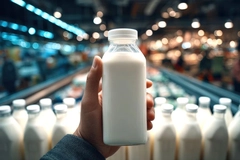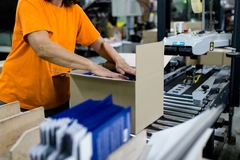Coca-Cola in paper bottles? Paboco prototype pursues “whole new world” of plastic-free possibilities

29 Oct 2020 --- Coca-Cola is working with paper bottle company Paboco to develop a recyclable paper bottle for non-alcoholic stills and sparkling drinks. The “first-generation” prototype consists of a paper shell with a closure and liner made from fully recycled PET.
The goal, however, is to create a paper bottle without a plastic liner that can be fully recycled as paper.
Coca-Cola’s EMEA R&D packaging innovation manager, Stijn Franssen, shares technical challenges, R&D motivations and other circular investments with PackagingInsights in this exclusive interview.
Road to commercialization
On its quest toward commercialization, the paper bottle must satisfy the standard safety and quality criteria for food packaging.
Franssen and his R&D team are extensively researching the bottle’s operational environment performance, durability on filling lines and transit, as well as the effect on the drinks inside. Other R&D challenges include withstanding water vapor and oxygen transmission.
Coca-Cola is exploring a paper bottle prototype to substantially reduce its use of virgin packaging materials.“Our overall aim is a new type of packaging solution that can play a role alongside other types of packaging in our packaging mix. This prototype is a key part of the development process, helping us move toward the next iteration of this bottle,” Franssen explains.
Motivated by EU policy
Amid scrutiny for being one of the world’s most polluting companies, Coca-Cola announced its World Without Waste commitment in 2018: “To collect and recycle the equivalent of one bottle for every bottle sold by 2030.”
Franssen outlines this is the primary motivator behind the paper bottle project, followed by European policy developments to reduce single-use plastic waste.
“We welcome developments that can bring us all closer to a more optimized way of working with the resources of our planet. We also pay close attention to the developments in our customers’ awareness and questions in delivering sustainable packaging solutions,” he affirms.
Why not research reusable?
Mounting research suggests that reusable packaging is more environmentally sustainable than paper, which can be resource- and energy-intensive.
This begs the question of why Coca-Cola would embark on a paper journey, as opposed to investing in reusable formats. Franssen responds that there is “no one size fits all approach.”
“Our starting point is to make packaging reusable or recyclable and many packaging formats have a role to play in delivering our drinks.”
 The first-generation paper bottle still contains aplastic closure and liner, but Franssen’s R&D team is working to eliminate this as well.“What works in Norway and creates the minimum possible footprint there isn’t necessarily going to work in the same way in Spain or Belgium. We do see significant opportunity in reusable packaging, which is why we are investing in package-free innovations,” Franssen explains.
The first-generation paper bottle still contains aplastic closure and liner, but Franssen’s R&D team is working to eliminate this as well.“What works in Norway and creates the minimum possible footprint there isn’t necessarily going to work in the same way in Spain or Belgium. We do see significant opportunity in reusable packaging, which is why we are investing in package-free innovations,” Franssen explains.
Retracting statements on plastic popularity?
At the Davos World Economic Forum in January, Coca-Cola’s head of sustainability, Bea Perez, maintained that “consumers still want single-use plastic bottles” and therefore the company would not stop using them.
Reflecting on that statement ten months later, Franssen highlights again that Coca-Cola does not believe there is a “one size fits all” solution to packaging in terms of drinking occasions and locations.
“Paper bottle technology has the potential to play an important role as part of our overall packaging mix. In parallel, we continue to invest in new packaging technologies and package-free innovation,” he explains.
“We’re committed to ensuring that all our packaging formats are circular and sustainable, whether it be PET, aluminum or glass, refillable bottles or our package-free solutions.”
These circular investments are necessary for the F&B giant to fulfill its World Without Waste commitment.
By Anni Schleicher











